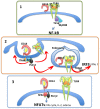Role of CD14 in host protection against infections and in metabolism regulation
- PMID: 23898465
- PMCID: PMC3721004
- DOI: 10.3389/fcimb.2013.00032
Role of CD14 in host protection against infections and in metabolism regulation
Abstract
CD14 is a glycosylphosphatidylinositol (GPI)-anchored receptor known to serve as a co-receptor for several Toll-like Receptors (TLRs) both at the cell surface and in the endosomal compartment. CD14 can be expressed by cells of both hematopoietic and non-hematopoietic origin as a cell membrane or secreted protein. Although CD14 was discovered more than 20 years ago, its activities remain largely to be defined. Most of the information available concerns CD14's role as a co-receptor working with TLR4 and facilitating cellular responses to low doses of lipopolysaccharide (LPS). Recent studies have highlighted and molecularly defined many other functions of this pattern recognition receptor (PRR). These functions include the mechanisms through which CD14 allows the activation of the TLR4-TRAM-TRIF pathway upon LPS stimulation; the capacity of CD14 to transduce a TLR4-independent signaling pathway leading to the activation of NFAT transcription factor family members with important consequences in myeloid cells; the CD14 influence on cell metabolism in conditions predisposing to obesity. In this review, we summarize recent progresses toward the molecular definition of the multiple roles exerted by CD14 in innate immune cells in response to LPS and the consequences of CD14 activation in physiologic and pathologic conditions.
Keywords: CD14; NFAT; innate immunity; lipopolysaccharide; pattern recognition receptors.
Figures

References
Publication types
MeSH terms
Substances
LinkOut - more resources
Full Text Sources
Other Literature Sources
Research Materials

